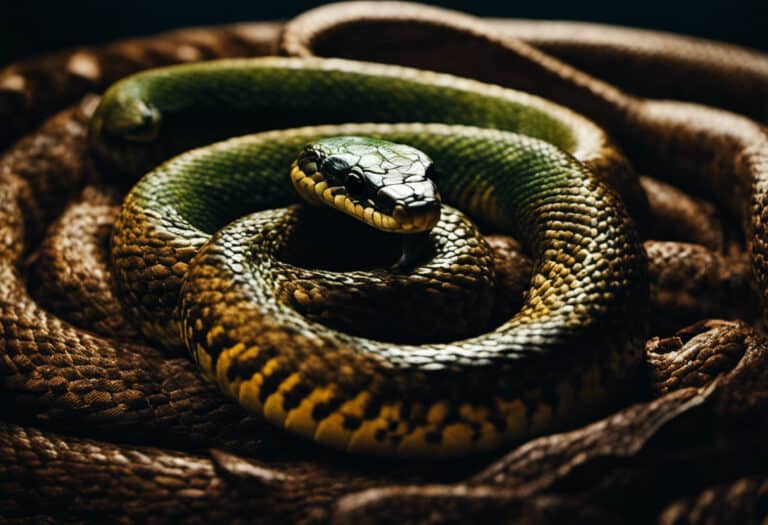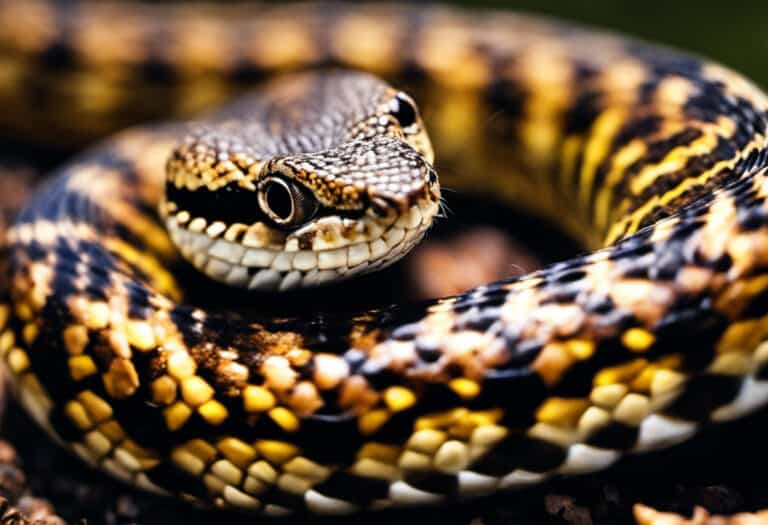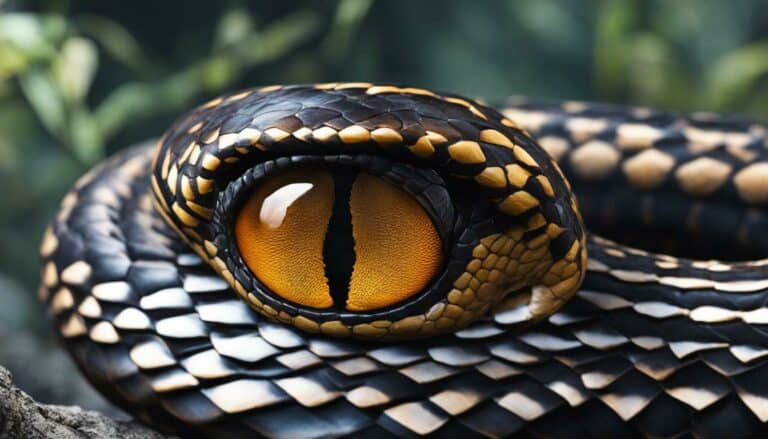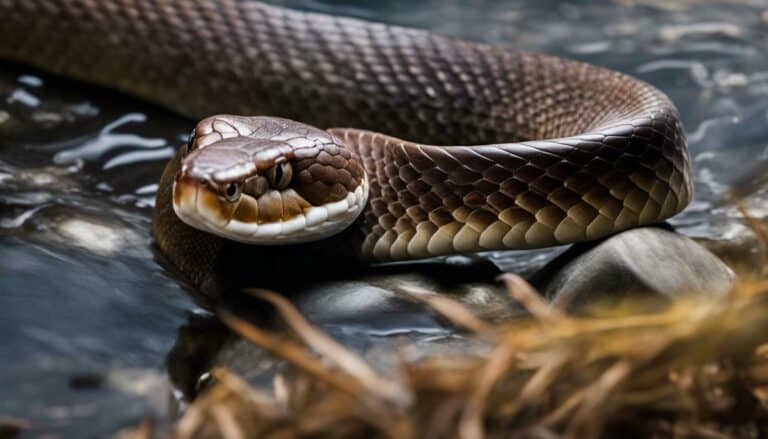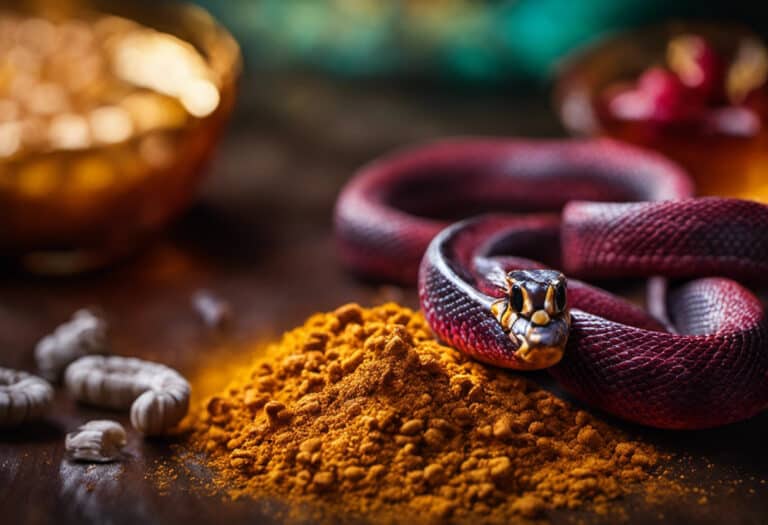What Kind of Snake Eats Rattlesnakes?
Are you curious which snakes have the guts to take on venomous rattlesnakes? Look no further! This article will take you on a thrilling journey into the world of snake-on-snake predation.
You’ll discover a range of snake species that have mastered the art of rattlesnake dining. From the agile Black Racers to the lightning-fast Coachwhips, these slithering hunters exhibit unique techniques and behaviors.
Kingsnakes, immune to rattlesnake venom, are notorious for effortlessly biting and constricting their evil counterparts. Uncover the secrets of these fearless reptilian predators!
Key Takeaways
- Black racers are not constrictors but can eat multiple newborn rattlesnakes at once.
- Coachwhips are fast visual hunters and eagerly consume rattlesnakes.
- Kingsnakes are notorious snake-eaters, immune to rattlesnake venom, and can bite them behind the head.
- Various species of kingsnakes, milk snakes, and indigo snakes are capable predators of rattlesnakes.
Black Racers
You should know that black racers aren’t constrictors; they grab and eat their prey headfirst.
Black racers, or Coluber constrictors, are non-venomous snakes in North America. They’re highly skilled hunters who use their speed and agility to capture their prey.
Unlike constrictors, black racers don’t coil around their prey to suffocate it; instead, they seize their prey with their sharp teeth and devour it headfirst. These snakes primarily feed on small mammals, birds, lizards, and frogs.
However, they’re known to compete with other snake species, particularly juvenile rattlesnakes. Black racers threaten young rattlesnakes’ survival, as they can consume multiple newborn rattlesnakes simultaneously.
While more giant rattlesnakes aren’t afraid of black racers, they still face competition for resources in their shared habitats.
Coachwhips
Coachwhips, known for their exceptional speed and agility, are visually oriented hunters that prowl with their heads held high.
They primarily prey on rodents, birds, lizards, and eggs, but they eagerly consume rattlesnakes when given the opportunity.
However, it remains uncertain whether coachwhips possess any immunity to rattlesnake venom.
Speed Vs. Stealth
Black racers are known for their speed and agility, while kingsnakes rely on stealth and their ability to overpower their prey. Regarding predation patterns, these two snake species employ different strategies.
With their exceptional speed, Black racers actively chase down their prey, often overtaking it in seconds. Their quick movements and agility allow them to capture their victims before they have a chance to escape.
On the other hand, kingsnakes utilize their stealthy nature to approach their prey silently. They patiently wait for the perfect moment to strike, overpowering their victims with their muscular bodies.
This contrast in hunting styles showcases the diverse adaptations of snakes, highlighting the different ways they’ve evolved to thrive in their environments.
Coachwhips Vs. Rattlesnakes
If you encounter a coachwhip in the wild, be cautious, as they’re known to consume rattlesnakes eagerly given the opportunity. Coachwhips are fast visual hunters that prey on rodents, birds, lizards, and eggs.
When it comes to rattlesnake predation patterns, coachwhips are a fascinating subject. Their hunting techniques involve prowling with their heads held high, allowing them to spot potential prey from a distance.
When a coachwhip encounters a rattlesnake, it may use its speed and agility to strike quickly, overpowering the snake before it can defend itself.
It’s unclear whether coachwhips have immunity to rattlesnake venom, but their ability to consume rattlesnakes suggests they may possess some resistance.
Further research is needed to fully understand the mechanisms behind this fascinating interaction between coachwhips and rattlesnakes.
Coachwhips’ Immunity to Venom?
You may be curious about the extent of coachwhips’ immunity to rattlesnake venom. Coachwhips, or Masticophis flagellum, are fascinating creatures with unique hunting techniques.
These fast visual hunters prowl with their heads held high, scanning their surroundings for potential prey. Coachwhips typically prey on rodents, birds, lizards, and eggs, but they eagerly consume rattlesnakes when given the chance.
Regarding their resistance to rattlesnake venom, the information is limited. It’s unclear if coachwhips have complete immunity to rattlesnake venom like kingsnakes.
However, they exhibit remarkable resistance, as they can consume rattlesnakes without succumbing to the venom’s effects. This suggests that coachwhips possess some level of protection against the toxic components of rattlesnake venom.
Further research is needed to determine the exact mechanisms behind coachwhips’ resistance to rattlesnake venom.
Studying their physiological and biochemical adaptations could provide valuable insights into their remarkable ability to hunt and consume these vicious predators.
Kingsnakes
Kingsnakes, such as the common kingsnake, are known for consuming rattlesnakes just as quickly as smaller snakes like garter snakes.
They possess a unique immunity to the venom of native pit vipers, making them formidable predators.
With the ability to bite the rattlesnakes behind the head and apply constricting coils, kingsnakes are well-equipped to overpower and consume their evil prey.
Immunity to Rattlesnake Venom
It’s unclear if coachwhips have immunity to rattlesnake venom. However, discussing the mechanism of immunity in snakes and the potential use of snake venom in medical research and treatment may shed some light on this topic.
- Mechanism of immunity to rattlesnake venom in snakes:
- Research suggests that some snakes have evolved specific adaptations to counteract the effects of poison.
- One mechanism is the production of antibodies that bind to and neutralize the venom’s toxins.
- Another mechanism involves changes in the structure of proteins and enzymes in the snake’s body, preventing the venom from causing harm.
- The potential use of snake venom in medical research and treatment:
- Snake venom contains many bioactive compounds that have shown promise in various medical applications.
- These compounds have been studied for their potential as painkillers, anti-coagulants, and cancer treatments.
- By understanding the mechanisms behind snake venom immunity, scientists may be able to develop new therapies and drugs for human health.
Understanding the immunity of snakes to rattlesnake venom provides insights into their survival strategies and opens up possibilities for medical advancements.
Constricting Coils or Not
If you encounter a black racer, you may be surprised it doesn’t rely on constricting coils to capture its prey. Unlike many other snakes, black racers are fast and agile hunters who employ speed rather than strength in their predation strategies.
These sleek snakes use their exceptional speed and maneuverability to chase down and seize their prey, which they then devour headfirst.
While black racers aren’t known to target rattlesnakes specifically, they threaten juvenile rattlesnakes.
They’ve been observed devouring multiple newborn rattlesnakes at once. However, it’s worth noting that more giant rattlesnakes aren’t afraid of black racers and may not view them as a significant threat.
Overall, black racers rely on speed and quick strikes to secure their meals, showcasing the balance between speed and strength in predation.
Subspecies and Their Preferences
When encountering other kingsnakes and milk snakes, you may find that specific data about their immunity to rattlesnake venom is lacking.
However, some subspecies of kingsnakes, such as the Arizona mountain kingsnake, California mountain kingsnake, and Mexican kingsnake, have been known to consume rattlesnakes. These snakes primarily prefer lizards but will occasionally eat other snakes.
It’s likely that most members of the Lampropeltis genus, which includes kingsnakes and milk snakes, exhibit some level of immunity to rattlesnake venom. Their feeding habits and hunting techniques vary depending on the subspecies and habitat preferences.
Kingsnakes are notorious snake-eaters, capable of consuming rattlesnakes as readily as garter snakes. They can bite rattlesnakes behind the head and apply constricting coils.
On the other hand, milk snakes primarily feed on rodents and small reptiles but may occasionally consume rattlesnakes.
Other Kingsnakes and Milk Snakes
You may find it interesting that most members of the Lampropeltis genus, such as prairie kingsnakes, milk snakes, Arizona mountain kingsnakes, California mountain kingsnakes, Mexican kingsnakes, and gray-banded kingsnakes, have been known to consume rattlesnakes.
Kingsnakes, including these subspecies, are notorious snake-eaters and can consume rattlesnakes as readily as they consume garter snakes.
What sets kingsnakes apart is their immunity to the venom of native pit vipers, including rattlesnakes. They can bite rattlesnakes behind the head and apply constricting coils to overpower them.
While specific data about the immunity of other kingsnakes and milk snakes to rattlesnake venom is lacking, most members of the Lampropeltis genus likely exhibit some level of immunity.
These snakes primarily prefer lizards but occasionally consume other snakes, including rattlesnakes.
Indigo Snakes
Did you know that indigo snakes are capable predators of rattlesnakes, and they eagerly consume small rattlesnakes?
Indigo snakes, also known as Drymarchon species, have developed unique predation techniques to overpower their prey. Here are some interesting facts about indigo snakes:
- Predation techniques:
- Indigo snakes overpower their prey by constriction, tightly coiling their muscular bodies around the game.
- They have a powerful bite, injecting venom into their prey to immobilize them.
- Their flexible jaws allow indigo snakes to swallow prey more significantly than their head.
- Habitat preferences:
- Indigo snakes are commonly found in the southeastern United States, mainly in sandy habitats, pine forests, and grasslands.
- They prefer to inhabit gopher tortoise burrows, using these underground shelters as a refuge and hunting ground.
- Indigo snakes also travel long distances for suitable prey and mating opportunities.
With their effective predation techniques and habitat preferences, indigo snakes are essential in controlling rattlesnake populations and maintaining ecological balance.
Mussuranas
Mussuranas, also known as Clelia snakes, inject venom through small fangs in the rear of their mouth.
These snakes are skilled hunters and employ various strategies to capture their prey. They are known to actively search for other snakes, including rattlesnakes, as their primary food source.
Mussuranas have developed venom resistance, allowing them to safely consume venomous snakes without being affected by their toxins.
Their hunting strategies involve overpowering their prey by biting and injecting venom, then constricting them until they become immobilized.
Mussuranas are highly adaptable and can be found in various habitats, from forests to grasslands. Their ability to consume venomous snakes showcases their freedom to thrive in challenging environments.
| Mussuranas | Hunting Strategies |
|---|---|
| Active search | Biting and injecting |
| Venom resistance | Constricting prey |
| Adaptability | Varied habitats |
Immunity to Rattlesnake Venom
It’s fascinating how some snakes, like the mussuranas, have developed immunity to rattlesnake venom. This immunity plays a crucial role in the rattlesnake predation cycle.
Venom is the critical tool rattlesnakes use to subdue their prey. It contains a cocktail of toxins that paralyze and kill their victims. However, certain snake species, such as the mussuranas, have evolved a remarkable adaptation.
Over time, these snakes have developed a genetic resistance to rattlesnake venom. This evolutionary process has allowed them to hunt and consume rattlesnakes without ill effects actively.
The evolution of immunity to rattlesnake venom in snake species demonstrates these creatures’ remarkable adaptability and resourcefulness in the face of dangerous predators.
Predation Patterns
Regarding predation patterns, certain snake species have developed unique strategies for hunting and consuming their prey.
There’s a balance between speed and stealth in the case of snake-eating snakes, such as kingsnakes, coachwhips, and black racers.
Coachwhips, known for their impressive speed, rely on their visual hunting abilities to quickly capture their prey, often prowling with their heads held high.
On the other hand, Black racers utilize their stealth and agility to grab their prey headfirst.
Kingsnakes possess a combination of speed and stealth, as they can bite rattlesnakes behind the head and apply constricting coils.
These predation patterns demonstrate the various adaptations that snakes have developed to successfully hunt and consume their prey, highlighting the importance of speed and stealth in their strategies.
Frequently Asked Questions
What Are the Predation Patterns of Black Racers, Coachwhips, Kingsnakes, Other Kingsnakes and Milk Snakes, Indigo Snakes, and Mussuranas?
Black racers, coachwhips, kingsnakes, other kingsnakes, milk snakes, indigo snakes, and mussuranas have varying predation patterns. Factors influencing their diet preferences include habitat, size, and immunity to venom.
Do Coachwhips Have Immunity to Rattlesnake Venom?
Coachwhips are fast visual hunters and eagerly consume rattlesnakes when given the chance. It is unclear if coachwhips have immunity to rattlesnake venom. Their predation patterns make them potential predators of rattlesnakes.
Which Subspecies of Kingsnakes Consume the Most Rattlesnakes?
Which subspecies of kingsnakes consume the most rattlesnakes? Kingsnakes, including the common kingsnake and various other species like milk snakes and gray-banded kingsnakes, have been known to consume rattlesnakes as readily as garter snakes.
Do Other Kingsnakes and Milk Snakes Exhibit Any Level of Immunity to Rattlesnake Venom?
Other kingsnakes and milk snakes may exhibit some immunity to rattlesnake venom, although specific data is lacking. Factors such as prey preference and habitat may influence snake predation on rattlesnakes.
How Do Indigo Snakes and Mussuranas Overpower and Consume Rattlesnakes?
Indigo snakes overpower and consume rattlesnakes by inhabiting gopher tortoise burrows and using their strength to overcome the prey. Mussuranas inject venom through small fangs in the rear of their mouth while consuming other snakes.
Conclusion
In conclusion, the world of snake-on-snake predation is filled with fascinating and unique species that have developed the skills and adaptations to consume rattlesnakes.
One interesting statistic is that Kingsnakes, known for their immunity to rattlesnake venom, are notorious snake-eaters and can effortlessly bite and constrict rattlesnakes. This showcases the remarkable adaptability and predatory prowess of these snakes.
Exploring the complex dynamics of snake predation provides valuable insights into the intricate natural balance of our ecosystems.

